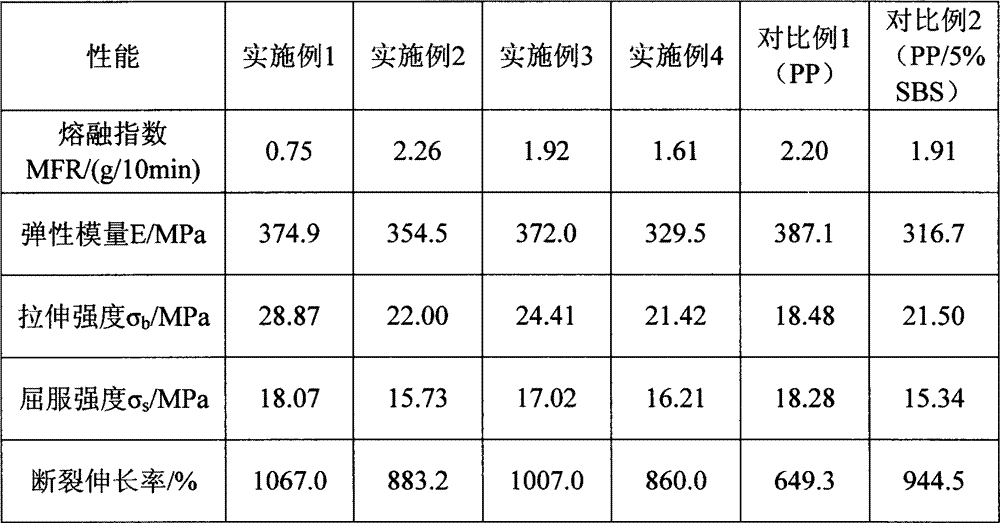Method for preparing styrene/isoprene in-situ toughened polypropylene
A technology of isoprene and polypropylene, which is applied in the field of in-situ toughened polypropylene preparation, can solve the problems of heavy odor, decrease of melting index, sacrifice of tensile strength and modulus of polypropylene matrix, etc., and achieve good performance, low cost effect
- Summary
- Abstract
- Description
- Claims
- Application Information
AI Technical Summary
Problems solved by technology
Method used
Image
Examples
Embodiment 1
[0026] At room temperature, 0.030kg of isoprene, 0.030kg of styrene and 0.003kg of di-tert-butyl peroxide are mixed uniformly; the temperature of the nine-stage heating barrel of the twin-screw extruder is preset to 70°C along the extrusion direction. , 170℃, 200℃, 200℃, 200℃, 200℃, 200℃, 200℃, 205℃, the screw speed is 100r / min; when the heating cylinder temperature reaches the set temperature, the 3kg melt index is 2.20g / 10min Polypropylene pellets from the first section of the extruder are fed into the extruder at a feed rate of 0.1kg / min; at the same time, styrene, isoprene and di-tert-butyl peroxide are fed from the metering pump The liquid feed port of the third stage is injected at a rate of 0.002kg / min; vacuum devolatilization is performed at the eighth stage of the extruder. The obtained samples were pelletized, prepared, and tested for melt index and mechanical properties. The results are shown in Table 1.
Embodiment 2
[0028] At room temperature, 0.045kg of isoprene, 0.015kg of styrene and 0.0024kg of di-tert-butyl peroxide are mixed uniformly; the temperature of the nine-stage heating barrel of the twin-screw extruder is preset to be 70°C along the extrusion direction. , 170℃, 200℃, 200℃, 200℃, 200℃, 200℃, 200℃, 205℃, the screw speed is 100r / min; when the heating cylinder temperature reaches the set temperature, the 3kg melt index is 2.20g / 10min Polypropylene pellets from the first section of the extruder are fed into the extruder at a feed rate of 0.1kg / min; at the same time, styrene, isoprene and di-tert-butyl peroxide are fed from the metering pump The liquid feed port of the third stage is injected at a rate of 0.002kg / min; vacuum devolatilization is performed at the eighth stage of the extruder. The obtained samples were pelletized, prepared, and tested for melt index and mechanical properties. The results are shown in Table 1.
Embodiment 3
[0030] At room temperature, 0.015kg of isoprene, 0.015kg of styrene and 0.0012kg of di-tert-butyl peroxide are mixed uniformly; the temperature of the nine-stage heating barrel of the twin-screw extruder is preset to 70°C along the extrusion direction. , 170℃, 200℃, 200℃, 200℃, 200℃, 200℃, 200℃, 205℃, the screw speed is 100r / min; when the heating cylinder temperature reaches the set temperature, the 3kg melt index is 2.20g / 10min Polypropylene pellets from the first section of the extruder are fed into the extruder at a feed rate of 0.1kg / min; at the same time, styrene, isoprene and di-tert-butyl peroxide are fed from the metering pump The liquid feeding port of the third stage is injected at a speed of 0.001kg / min; vacuum devolatilization is performed at the eighth stage of the extruder. The obtained samples were pelletized, prepared, and tested for melt index and mechanical properties. The results are shown in Table 1.
PUM
| Property | Measurement | Unit |
|---|---|---|
| melt flow index | aaaaa | aaaaa |
| melt flow index | aaaaa | aaaaa |
Abstract
Description
Claims
Application Information
 Login to View More
Login to View More - R&D Engineer
- R&D Manager
- IP Professional
- Industry Leading Data Capabilities
- Powerful AI technology
- Patent DNA Extraction
Browse by: Latest US Patents, China's latest patents, Technical Efficacy Thesaurus, Application Domain, Technology Topic, Popular Technical Reports.
© 2024 PatSnap. All rights reserved.Legal|Privacy policy|Modern Slavery Act Transparency Statement|Sitemap|About US| Contact US: help@patsnap.com








